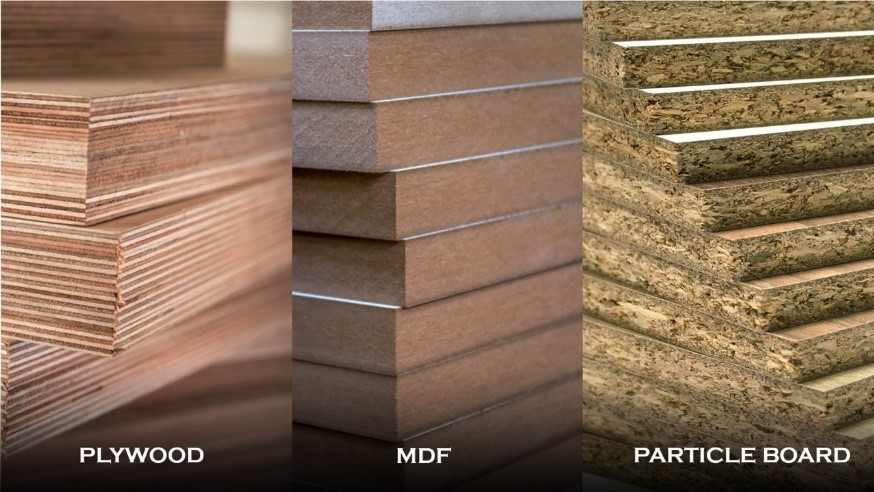
Plywood, Particle board, MDF – How does a common man define each? By the term either it’s “a type of wood” or “a sheet of material”. But, for someone who takes interior design seriously, the mind would be packed up with endless questions like – “What are these materials actually? What are their differences? Which one is best for the interiors? Which one is the most affordable? etc.” And that’s exactly why we, the team here at Arrivae, thought it’s time to educate the world about these three types of wood by explaining the pros and cons of each and also their differences to make the purchasing decisions easy. Though they may be side-by-side in the same aisle at your home improvement store, they aren’t interchangeable. Determine which works better in your project by weighing these key differences.
So, Here Are The Basics: Plywood Vs Particle Board Vs MDF
What is Plywood?
Plywood is a type of manufactured wood that is made by pressing and binding thin sheets or fine layers of wood veneers together into one solid piece.
Pros and Cons of Plywood
| Pros |
Cons |
| Plywood is a very strong material and hence it is less susceptible to damages. | Plywood is a bit expensive and hence it can be heavy on the pocket. |
| It exhibits high dimensional stability with reduced expansion and shrinkage. | Since it has high strength, plywood is difficult to cut and mould. |
| As strong adhesives are used in its manufacture, plywood is highly durable. | Because of the layers that show on the edges, the edges of the plywood have to be finished with either veneer or laminate. |
| Because of its stronger cross-grain pattern, plywood holds nails and screws well. | Since its edges splinter, it’s hard to get a smooth cut with plywood. |
| It’s less susceptible to water damage and doesn’t soak up water quickly. Though regular plywood is not exactly waterproof, marine plywood is. | |
| As it takes paints and stains very well, it is perfect for projects that require large stained wood surfaces. | |
| It is a highly versatile product and has its application both indoors and outdoors. |
What is Particle Board?
Particle board is a sheet material which is brought to life by heat pressing wood chips, sawmill shavings or sawdust, wood scraps or wood residues with the help of an adhesive resin.
Pros and Cons of Plywood
|
Pros |
Cons |
| Particle boards are low on cost and hence they are budget-friendly. | It is low on strength and hence cannot support heavy loads. |
| Since the surface of the particleboard is usually smooth, the end products look more neat and stunning. | Since its manufacturing process involves the usage of urea-formaldehyde resin, these boards can be toxic. |
| Sticking decorative laminates or wood veneers also gets easy with particle board because of its smooth and flat surface. | When exposed to a considerable amount of moisture, it expands, warps and discolours easily. |
| Because of its light-weight nature, the furniture made out of these boards is relatively easy to lift and transport. | It doesn’t hold up well against nails and screws and also exhibits susceptibility to damage, all because of its softer and more brittle composition. |
| Since it is made out of scraps of other lumber products and no additional cutting of trees happens, it is environmentally-friendly. | It has relatively low durability, which would affect the life of the furniture made out of it as well. |
| They are perfect for ready-made furniture. | |
| Thermo-acoustic insulation property of particle boards makes it a perfect wood material for the false ceiling of auditoriums, theaters, etc. |
What is MDF?
Medium Density Fibreboard (MDF) is an engineered wood that is made by breaking down hardwood or softwood residuals into fine particles and fusing them together with wax and a resin binder under high pressure and heat.
Pros and Cons of Plywood
| Pros |
Cons |
| MDF is clearly denser and stronger than particle board. | Since it is dense and heavy, it is difficult to work with this material single-handedly. |
| Its surface is very smooth and has no knots, which makes a great base for painting and finishing. | It is not water-resistant and hence exhibits a tendency to soak up water and swell, unless it’s well sealed on all sides and edges with a waterproof finish. |
| It does not warp or crack when there are fluctuations in temperature and humidity. | Since it is made from fine particles, MDF does not hold nails and screws well. |
| Due to its structure and consistency, MDF is easy to cut and drill without producing splinters or chipping. So, ease of customization is generally high with MDF. | If handled roughly or without care, MDF easily suffers damages and sags. |
| It is cheaper at cost than plywood. | |
| As it is made from wood residuals and no extra tree is cut down, it makes for an environmental-friendly product. | |
| MDF is clearly denser and stronger than particle board. | Since it is dense and heavy, it is difficult to work with this material single-handedly. |
Plywood Vs Particle Board Vs MDF: Differences
| Parameter | Plywood | Particle Board | MDF |
| Constituents | Wood veneers | Wood chips and sawdust | Wood residuals |
| Strength | High on strength | Low on strength | Not as strong as plywood |
| Water resistance | High (with marine plywood) | Low | Low |
| Cost-effectiveness | Relatively expensive | Cheaper than MDF | Cheaper than Plywood |
| Ease of Working | Difficult | Relatively easy | Easier than plywood |
| Dimensional Stability | High | Low | Relatively Low |
| Nail and screw holding capacity | High | Low | Low |
| Environmental-friendliness
(based on raw-material used) |
Yes (if raw-material is sourced from renewable and sustainable forests) | Yes (but emits formaldehyde as off-gas) | Yes (Relatively) |
| Application | Suitable for both indoor and outdoor applications such as for fabricating wardrobes, kitchen cabinets, doors, shutters, floors, exterior walls, exterior stairs, lawn chairs and tables, etc. | For interiors of home, floors, fittings and fixtures, furniture, etc. | More suited for indoor use( as it doesn’t handle moisture well) and also for constructing interior design pieces |
The bottom line: The type of project will guide your decision.
Plywood and MDF are useful materials for many DIY projects around the home. As a general rule, however, MDF is the better choice for indoor furniture or decorative use, especially if you want to cut intricately carved trim or designs, and plan on painting the finished project. Plywood is excellent for outdoor use, for framing walls or building floors, for crafting kitchen or bathroom cabinets, and for projects that require a curve. You can use particle boards as moulding or trimming for your floors, windows, ceilings or doors. This can help give your home some added beauty, eventually giving it a new “aura.” Particle boards, as a rule, should not be used as floors. However, you can use them to cover your hardwood floors, as protection.

